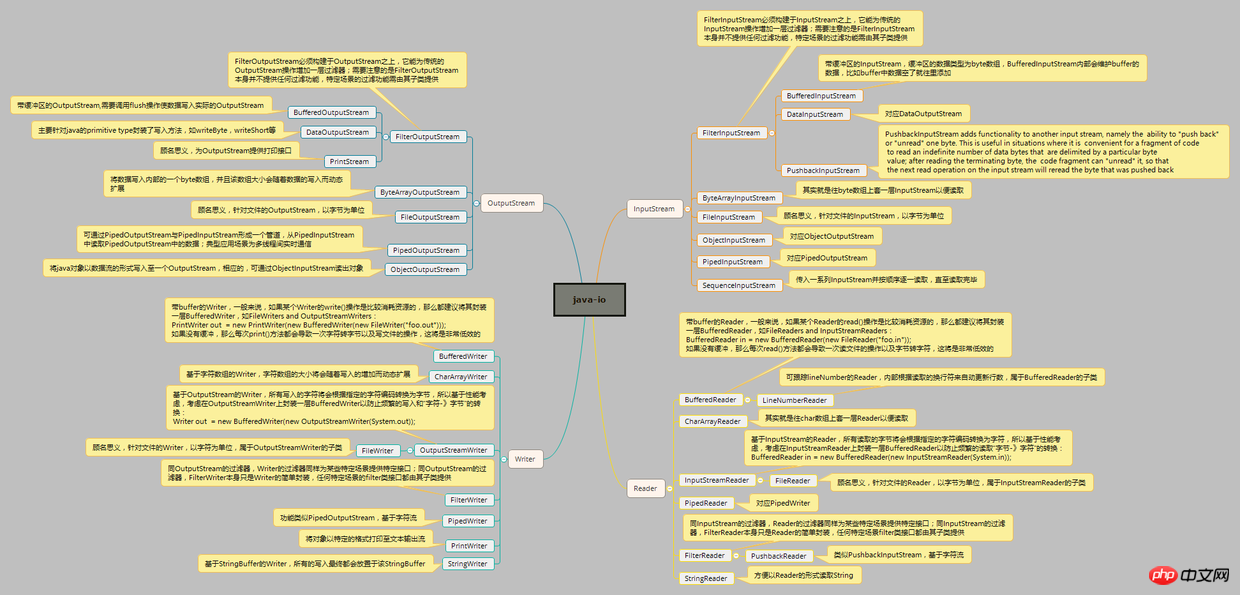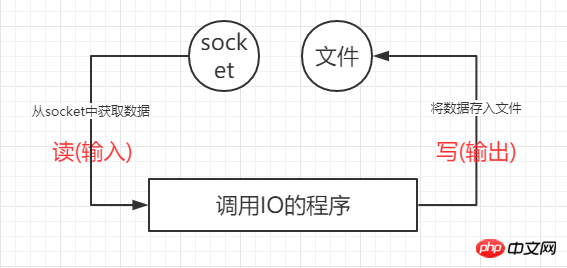A brief introduction to getting started with IO in Java (picture)
Overall structure
IO should be the most commonly used function in daily projects. Whether it is simple file reading or server port monitoring, IO will be used; however, when facing the Java IO package When using a complex IO basic class library, you often get confused. Should you choose InputStream or Reader? Should you add a to InputStream? Buffer? How to choose the appropriate class library according to the application scenario is a problem faced by many coders. Here I have sorted out the commonly used class libraries in the Java IO package, including their organizational structure, functional features, applicable scenarios, etc., to To facilitate subsequent use, you can quickly and easily select the most appropriate IO class according to your needs

According to the analysis diagram, IO can be divided into two dimensions from a large level:
Data type, that is: characters or bytes, class corresponding to
Writer/ReaderorOutputStream/InputStreamOperation type, that is: read (input) or write (output), the class corresponds to
Reader/InputStreamorWriter/OutputStream
Usage Skills
All operations of Java IO are nothing more than extensions of the four main classes in these two dimensions. Most of them are relatively simple. Here are some points that are slightly difficult to understand and worth noting. A separate explanation
Java IO uses the Decorator pattern extensively, so generally when using the IO class library, the Decorator calling method is used:
PrintWriter out = new PrintWriter(new BufferedWriter(new FileWriter("foo.out")));In Java IO, whether it is the reading and writing of characters or the reading and writing of bytes, there is basically a one-to-one correspondence. In other words, there is a specific reading class. Generally, There will be a specifically written class. Grasping this can simplify the complex. For example,
FileInputStreamandFileOutputStreamcorrespond to file reading and writing respectively;PipedInputStreamandPipedOutputStreamcorrespond to the reading and writing of pipe data respectively.How to distinguish reading or writing is a problem that often troubles novices. , here I provide a simple way to distinguish: using the program you are currently running as the benchmark (that is, the program that calls IO), data transferred from the program to other places is written (output), and data transferred from other places to the program is read. (Input); if the data generated by the program is stored in the log file, then it is written. If the data is obtained from the port and processed in the program, it is read

Select the appropriate IO class for assembly based on the action to be performed and the target data type, combined with the usage scenario. Note that the above sentence actually involves three steps:
The action to be performed is to read or write.
The data type is byte or character, and sometimes Conversion of characters and bytes is required (such as
OutputStreamWriter); if data needs to be stored on the network or in memory, it is generally in the form of bytes; or writing of files, text files This kind of character encoding itself is generally in the character form, but for pictures, videos and other files, it can only use the byte formUsage scenarios, in fact, the usage scenarios need to be considered in two steps , first consider the obvious scenarios, such as file operations, string operations, or pipe communication; secondly, you need to consider performance, such as whether file writing operations will be more frequent. If so, it is recommended to encapsulate them through BufferedWriter, because It is a very inefficient way to open and write a small amount of data every time
Summary
This article mainly focuses on the basic IO classes Briefly sort out, and explain the basic concepts in IO and how to use the IO basic class library. Of course, this article does not list all IO implementation classes. Interested students can check the Java documentation or source code by themselves. At the same time, this article also How to customize the IO class library yourself? In fact, under normal circumstances, the basic class library provided by Java is enough to meet the needs; in addition, Java introduced NIO after 1.4, namely: No Blocking IO, which is somewhat different from the original IO usage scenarios
The above is the detailed content of A brief introduction to getting started with IO in Java (picture). For more information, please follow other related articles on the PHP Chinese website!

Hot AI Tools

Undresser.AI Undress
AI-powered app for creating realistic nude photos

AI Clothes Remover
Online AI tool for removing clothes from photos.

Undress AI Tool
Undress images for free

Clothoff.io
AI clothes remover

Video Face Swap
Swap faces in any video effortlessly with our completely free AI face swap tool!

Hot Article

Hot Tools

Notepad++7.3.1
Easy-to-use and free code editor

SublimeText3 Chinese version
Chinese version, very easy to use

Zend Studio 13.0.1
Powerful PHP integrated development environment

Dreamweaver CS6
Visual web development tools

SublimeText3 Mac version
God-level code editing software (SublimeText3)

Hot Topics
 Java Spring Interview Questions
Aug 30, 2024 pm 04:29 PM
Java Spring Interview Questions
Aug 30, 2024 pm 04:29 PM
In this article, we have kept the most asked Java Spring Interview Questions with their detailed answers. So that you can crack the interview.
 Break or return from Java 8 stream forEach?
Feb 07, 2025 pm 12:09 PM
Break or return from Java 8 stream forEach?
Feb 07, 2025 pm 12:09 PM
Java 8 introduces the Stream API, providing a powerful and expressive way to process data collections. However, a common question when using Stream is: How to break or return from a forEach operation? Traditional loops allow for early interruption or return, but Stream's forEach method does not directly support this method. This article will explain the reasons and explore alternative methods for implementing premature termination in Stream processing systems. Further reading: Java Stream API improvements Understand Stream forEach The forEach method is a terminal operation that performs one operation on each element in the Stream. Its design intention is
 PHP: A Key Language for Web Development
Apr 13, 2025 am 12:08 AM
PHP: A Key Language for Web Development
Apr 13, 2025 am 12:08 AM
PHP is a scripting language widely used on the server side, especially suitable for web development. 1.PHP can embed HTML, process HTTP requests and responses, and supports a variety of databases. 2.PHP is used to generate dynamic web content, process form data, access databases, etc., with strong community support and open source resources. 3. PHP is an interpreted language, and the execution process includes lexical analysis, grammatical analysis, compilation and execution. 4.PHP can be combined with MySQL for advanced applications such as user registration systems. 5. When debugging PHP, you can use functions such as error_reporting() and var_dump(). 6. Optimize PHP code to use caching mechanisms, optimize database queries and use built-in functions. 7
 PHP vs. Python: Understanding the Differences
Apr 11, 2025 am 12:15 AM
PHP vs. Python: Understanding the Differences
Apr 11, 2025 am 12:15 AM
PHP and Python each have their own advantages, and the choice should be based on project requirements. 1.PHP is suitable for web development, with simple syntax and high execution efficiency. 2. Python is suitable for data science and machine learning, with concise syntax and rich libraries.
 Java Program to Find the Volume of Capsule
Feb 07, 2025 am 11:37 AM
Java Program to Find the Volume of Capsule
Feb 07, 2025 am 11:37 AM
Capsules are three-dimensional geometric figures, composed of a cylinder and a hemisphere at both ends. The volume of the capsule can be calculated by adding the volume of the cylinder and the volume of the hemisphere at both ends. This tutorial will discuss how to calculate the volume of a given capsule in Java using different methods. Capsule volume formula The formula for capsule volume is as follows: Capsule volume = Cylindrical volume Volume Two hemisphere volume in, r: The radius of the hemisphere. h: The height of the cylinder (excluding the hemisphere). Example 1 enter Radius = 5 units Height = 10 units Output Volume = 1570.8 cubic units explain Calculate volume using formula: Volume = π × r2 × h (4
 PHP vs. Python: Core Features and Functionality
Apr 13, 2025 am 12:16 AM
PHP vs. Python: Core Features and Functionality
Apr 13, 2025 am 12:16 AM
PHP and Python each have their own advantages and are suitable for different scenarios. 1.PHP is suitable for web development and provides built-in web servers and rich function libraries. 2. Python is suitable for data science and machine learning, with concise syntax and a powerful standard library. When choosing, it should be decided based on project requirements.
 PHP vs. Other Languages: A Comparison
Apr 13, 2025 am 12:19 AM
PHP vs. Other Languages: A Comparison
Apr 13, 2025 am 12:19 AM
PHP is suitable for web development, especially in rapid development and processing dynamic content, but is not good at data science and enterprise-level applications. Compared with Python, PHP has more advantages in web development, but is not as good as Python in the field of data science; compared with Java, PHP performs worse in enterprise-level applications, but is more flexible in web development; compared with JavaScript, PHP is more concise in back-end development, but is not as good as JavaScript in front-end development.
 Create the Future: Java Programming for Absolute Beginners
Oct 13, 2024 pm 01:32 PM
Create the Future: Java Programming for Absolute Beginners
Oct 13, 2024 pm 01:32 PM
Java is a popular programming language that can be learned by both beginners and experienced developers. This tutorial starts with basic concepts and progresses through advanced topics. After installing the Java Development Kit, you can practice programming by creating a simple "Hello, World!" program. After you understand the code, use the command prompt to compile and run the program, and "Hello, World!" will be output on the console. Learning Java starts your programming journey, and as your mastery deepens, you can create more complex applications.






